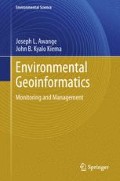Abstract
Geographic Information System(GIS) is defined as a special type of information system that is used to input, store, retrieve, process, analyze and visualize geospatial data and information in order to support decision making, see e.g.,Aronoff (1989), Tomlinson (2007), Longley et al. (2005), Konecny (2003), Burrough (1986), Murai (1999) etc.
“Knowing where things are, and why, is essential to rational decision making” Jack Dangermond, Founder ESRI
Access this chapter
Tax calculation will be finalised at checkout
Purchases are for personal use only
Notes
- 1.
- 2.
Reductions in Emissions from Deforestation in Developing countries.
References
Aronoff S (1989) Geographic information systems: a management perspective. WDL Publications, Ottawa
Burrough PA (1986) Principles of geographical information systems for land resources assessment. Oxford University Press, New York, 50 pp
Fédération Internationale des Géométres (2001) http://www.fig.net. Accessed 11 June 2010
Konecny G (2003) Geoinformation: remote sensing, photogrammetry, geographic information systems. Taylor and Francis, New York
Longley PA, Goodchild MF, Maguire DJ, Rhind DW (2005) Geographic information systems and science. Wiley, West Sussex
Murai S (1999) GIS work book: fundamental and technical courses, vols 1–2. National Space Development Agency
Murai S (2004) Remote sensing and GIS courses—distance education. Japan International Cooperation Agency (JICA)-Net
Sherman GE (2008) Desktop GIS: mapping the planet with open source tools. The Pragmatic Bookshelf, Raleigh
Tomlinson RF (2007) Thinking about GIS: geographic information system planning for managers. ESRI Press, New York
UCGIS (University Consortium for Geographic Information Science) (2003) The Strawman report: development of model undergraduate curricula for geographic information science & technology. Task Force on the Development of Model Undergraduate Curricula, University Consortium for Geographic Information Science
Weng Q (2010) Remote sensing and GIS integration: theories, methods, and applications. McGraw-Hill, New York 416 pp
Author information
Authors and Affiliations
Corresponding author
Rights and permissions
Copyright information
© 2013 Springer-Verlag Berlin Heidelberg
About this chapter
Cite this chapter
Awange, J.L., Kyalo Kiema, J.B. (2013). Fundamentals of GIS. In: Environmental Geoinformatics. Environmental Science and Engineering(). Springer, Berlin, Heidelberg. https://doi.org/10.1007/978-3-642-34085-7_13
Download citation
DOI: https://doi.org/10.1007/978-3-642-34085-7_13
Published:
Publisher Name: Springer, Berlin, Heidelberg
Print ISBN: 978-3-642-34084-0
Online ISBN: 978-3-642-34085-7
eBook Packages: Earth and Environmental ScienceEarth and Environmental Science (R0)

